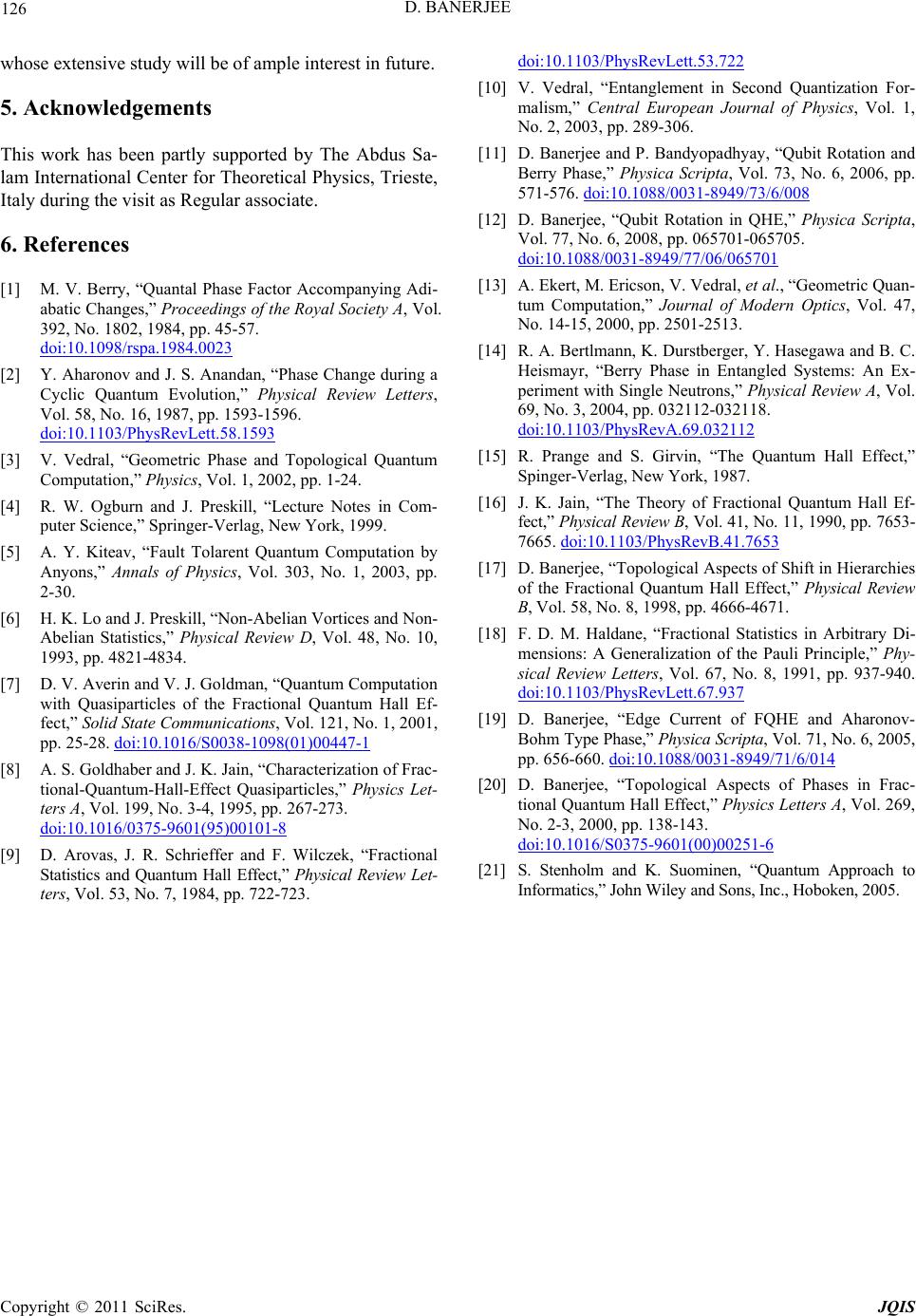
D. BANERJEE
Copyright © 2011 SciRes. JQIS
126
whose extensive study will be of ample interest in future.
5. Acknowledgements
This work has been partly supported by The Abdus Sa-
lam International Center for Theoretical Physics, Trieste,
Italy during the visit as Regular associate.
6. References
[1] M. V. Berry, “Quantal Phase Factor Accompanying Adi-
abatic Changes,” Proceedings of the Royal Society A, Vol.
392, No. 1802, 1984, pp. 45-57.
doi:10.1098/rspa.1984.0023
[2] Y. Aharonov and J. S. Anandan, “Phase Change during a
Cyclic Quantum Evolution,” Physical Review Letters,
Vol. 58, No. 16, 1987, pp. 1593-1596.
doi:10.1103/PhysRevLett.58.1593
[3] V. Vedral, “Geometric Phase and Topological Quantum
Computation,” Physics, Vol. 1, 2002, pp. 1-24.
[4] R. W. Ogburn and J. Preskill, “Lecture Notes in Com-
puter Science,” Springer-Verlag, New York, 1999.
[5] A. Y. Kiteav, “Fault Tolarent Quantum Computation by
Anyons,” Annals of Physics, Vol. 303, No. 1, 2003, pp.
2-30.
[6] H. K. Lo and J. Preskill, “Non-Abelian Vortices and Non-
Abelian Statistics,” Physical Review D, Vol. 48, No. 10,
1993, pp. 4821-4834.
[7] D. V. Averin and V. J. Goldman, “Quantum Computation
with Quasiparticles of the Fractional Quantum Hall Ef-
fect,” Solid State Communications, Vol. 121, No. 1, 2001,
pp. 25-28. doi:10.1016/S0038-1098(01)00447-1
[8] A. S. Goldhaber and J. K. Jain, “Characterization of Frac-
tional-Quantum-Hall-Effect Quasiparticles,” Physics Let-
ters A, Vol. 199, No. 3-4, 1995, pp. 267-273.
doi:10.1016/0375-9601(95)00101-8
[9] D. Arovas, J. R. Schrieffer and F. Wilczek, “Fractional
Statistics and Quantum Hall Effect,” Physical Review Let-
ters, Vol. 53, No. 7, 1984, pp. 722-723.
doi:10.1103/PhysRevLett.53.722
[10] V. Vedral, “Entanglement in Second Quantization For-
malism,” Central European Journal of Physics, Vol. 1,
No. 2, 2003, pp. 289-306.
[11] D. Banerjee and P. Bandyopadhyay, “Qubit Rotation and
Berry Phase,” Physica Scripta, Vol. 73, No. 6, 2006, pp.
571-576. doi:10.1088/0031-8949/73/6/008
[12] D. Banerjee, “Qubit Rotation in QHE,” Physica Scripta,
Vol. 77, No. 6, 2008, pp. 065701-065705.
doi:10.1088/0031-8949/77/06/065701
[13] A. Ekert, M. Ericson, V. Vedral, et al., “Geometric Quan-
tum Computation,” Journal of Modern Optics, Vol. 47,
No. 14-15, 2000, pp. 2501-2513.
[14] R. A. Bertlmann, K. Durstberger, Y. Hasegawa and B. C.
Heismayr, “Berry Phase in Entangled Systems: An Ex-
periment with Single Neutrons,” Physical Review A, Vol.
69, No. 3, 2004, pp. 032112-032118.
doi:10.1103/PhysRevA.69.032112
[15] R. Prange and S. Girvin, “The Quantum Hall Effect,”
Spinger-Verlag, New York, 1987.
[16] J. K. Jain, “The Theory of Fractional Quantum Hall Ef-
fect,” Physical Review B, Vol. 41, No. 11, 1990, pp. 7653-
7665. doi:10.1103/PhysRevB.41.7653
[17] D. Banerjee, “Topological Aspects of Shift in Hierarchies
of the Fractional Quantum Hall Effect,” Physical Review
B, Vol. 58, No. 8, 1998, pp. 4666-4671.
[18] F. D. M. Haldane, “Fractional Statistics in Arbitrary Di-
mensions: A Generalization of the Pauli Principle,” Phy-
sical Review Letters, Vol. 67, No. 8, 1991, pp. 937-940.
doi:10.1103/PhysRevLett.67.937
[19] D. Banerjee, “Edge Current of FQHE and Aharonov-
Bohm Type Phase,” Physica Scripta, Vol. 71, No. 6, 2005,
pp. 656-660. doi:10.1088/0031-8949/71/6/014
[20] D. Banerjee, “Topological Aspects of Phases in Frac-
tional Quantum Hall Effect,” Physics Letters A, Vol. 269,
No. 2-3, 2000, pp. 138-143.
doi:10.1016/S0375-9601(00)00251-6
[21] S. Stenholm and K. Suominen, “Quantum Approach to
Informatics,” John Wiley and Sons, Inc., Hoboken, 2005.